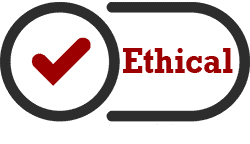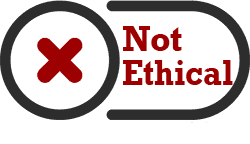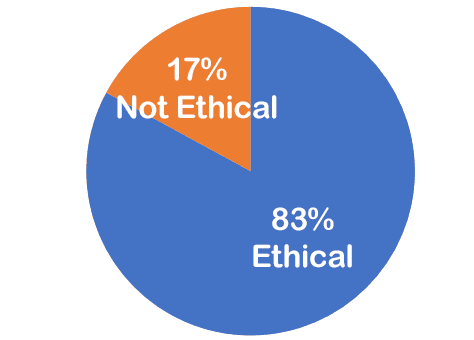This is the May 2023 edition of our monthly series of Ethics case studies titled What Do You Think? This series is comprised of case studies from NSPE archives, involving both real and hypothetical matters submitted by engineers, public officials and members of the public.
Your peers and the NSPE Board of Ethical Review have reviewed the facts of the case as shown below. And, here are the results.
Your opinion has been registered for the May 2023 edition of our monthly series of Ethics case studies titled What Do You Think?
Your vote is recorded as:

Want to know how your peers voted? We’ll send you an email with the poll results on May 23.
Your opinion has been registered for the May 2023 edition of our monthly series of Ethics case studies titled What Do You Think?
Your vote is recorded as:

Want to know how your peers voted? We’ll send you an email with the poll results on May 23.
A Review of the Facts
Engineer Ben is hired by Client X to develop a design for a project. After Ben develops what he believes to be the best design and meets with Client X to discuss the design plans and specifications, Client X and Ben enter a dispute concerning the project’s ultimate success. The client believes Ben’s design is too large and complex and seeks a simpler solution to the project. Ben believes a simpler solution will not achieve the result and could endanger the public.
The client demands that Ben deliver over to them the drawings so that they can be presented to Engineer Charles to assist Charles in completing the project to the client’s liking. The client is willing to pay for the drawings, plans, specifications, and preparation, but will not pay until Ben delivers over the drawings. Ben initially refuses, but he eventually delivers the drawings to Client X.
What Do You Think?
Was it ethical for Ben to deliver the drawings to Client X?
Here is the result of our survey of your peers:

Applicable NSPE Code References:
II.1.a
Engineers shall hold paramount the safety, health, and welfare of the public. If engineers’ judgment is overruled under circumstances that endanger life or property, they shall notify their employer or client and such other authority as may be appropriate.II.1.f
Engineers having knowledge of any alleged violation of this Code shall report thereon to appropriate professional bodies and, when relevant, also to public authorities, and cooperate with the proper authorities in furnishing such information or assistance as may be required.III.1.b
Engineers shall advise their clients or employers when they believe a project will not be successful.
Discussion
The facts of the case presented to the Board, at first glance, appear to be fairly straightforward and easily addressed by the Code of Ethics. On its face we are presented with an engineer who has been retained by a client to design a project. However, both parties cannot agree as to the ultimate success of the project as developed by Ben. Thus, the client seeks to terminate the services of Ben, but wishes to obtain the drawings, plans, and specifications from Ben for a fee. Our discussion will be limited to the ethical rather than the contractual considerations of this case.
Much of the language contained in the Code relates to the engineer’s obligation to protect the public health, property, and welfare (Code II.1.a.). In the present case it appears that Ben had a strong concern for the protection of the public health and welfare. Nevertheless, it is the view of this Board that Ben could have delivered over the drawings to the client and his conduct would have been ethically proper.
While it is true that Ben has an ethical obligation under Code II.1.a., that obligation assumes that Ben is in possession of verifiable facts or evidence which would substantiate a charge that an actual danger to the public health or safety exists. In the instant case, Ben makes the overly broad assumption that if he were to deliver over to the client the drawings so that the client can present them to Charles to assist Charles in completing the project to the client’s liking, Charles would develop a set of plans which would endanger the public health and safety. We think that such an assumption is ill-founded and is not based upon anything more than a supposition by Ben. Therefore, we are of the view that Ben should not have withheld the drawings on the basis of Code II.1.a.
In reviewing the conduct of Ben up until his refusal to deliver over the drawings to the client, we are of the view that Ben went as far as he was ethically required to go in preparing what he believed was the best design for the project and in informing the client of the dangers of proceeding with the client’s simplified solution. Code III.1.b. is very clear in stating an “Engineer shall advise [his] client. . . when [he] believes a project will not be successful.” We are of the view that, by conferring with the client and explaining his concerns over a proposed simplified solution, Ben had met his ethical responsibility.
If, after Ben does deliver the drawings over to the client, he discovers that Charles develops plans which constitute a danger to the public, certain actions would then be required by Ben under the Code. Any verifiable conduct on the part of Charles which indicates that Charles’s plans are a danger to the public, should be brought to the attention of the proper authorities, i.e., the responsible professional societies or the state engineering registration board.
The Ethical Review Board’s Conclusion

It was ethical for Ben to deliver over the drawings to Client X.
BOARD OF ETHICAL REVIEW
Wendell Beard, P.E. Robert J. Haefeli, P.E. Ernest C. James, P.E. Robert W. Jarvis, P.E. James L. Polk, P.E. J. Kent Roberts, P.E. Alfred H. Samborn, P.E., chairman
Note – In regard to the question of application of the Code to corporations vis-a-vis real persons, business form or type should not negate nor influence conformance of individuals to the Code. The Code deals with professional services, which services must be performed by real persons. Real persons in turn establish and implement policies within business structures. The Code is clearly written to apply to the Engineer and it is incumbent on a member of NSPE to endeavor to live up to its provisions. This applies to all pertinent sections of the Code. This opinion is based on data submitted to the Board of Ethical Review and does not necessarily represent all of the pertinent facts when applied to a specific case. This opinion is for educational purposes only and should not be construed as expressing any opinion on the ethics of specific individuals. This opinion may be reprinted without further permission, provided that this statement is included before or after the text of the case.








Ben was under contract agreed to by both parties and he provided HIS CONCEPT that he believes was doable and safe. I see no issue with providing his design that he was paid for. It is up to the client whether or not to utilize said design.
Also, do one knows what the next engineer would recommend or design, no matter what the customer requested. So, it is hypothetical to think that another engineer would deliver a design that is not in the public’s or customers best interests.
It does not mention whether Ben had a contract with Client X indicating the contract terms and requirements.
It does not indicate if Ben had signed and sealed the plans prior to handing them over and if the plans met the requirements of the “contract”, if any.
Need more info.
My understanding is that Ben’s original design poses no threat to public safety, so there should be no problem of him delivering it to the client. Once the plan is altered by Charles, Charles is taking the ownership and responsibility.
Unless Ben has knowledge about how Charles changes the original plan and concerns about the changes will endanger the public but chose not to report to authority, he has done nothing non-ethical.
I do not agree with this binary answer. The correct answer, in my view, is that Ben turns over the design BUT with a written statement, signed off by the client, that states Ben’s reasons for believing that other designes would be dangerous. Absent his stating his views in writing, Charles may overlook issues Ben discovered and make a design mistake. Also, once this statement is given to the client and signed off, I think that Ben’s ethical responsibilities will have been met, and Ben would not need to further keep track (with no compensation) as to what Charles does. Indeed, he is no longer a party to the design at that point.
This is not really an ethics issue. It’s all about professional liability and how to ensure that Engineer Charles is the Engineer of record and responsible in all regards for the content of the final project. Ben should remove his Company name from the work products and obtain a written hold harmless agreement in exchange for the drawings in addition to being fairly compensated for what he has done.
I don’t see this as a question of ethics. Ben was hired by the client. Ben just needs to deliver the product as is as requested by the client and get paid. What the client does with Ben’s product should not be Ben’s concern or future problem.
Several questions about your conclusion of ethical. How will Ben have access to the completed design to evaluate it? The client has stated that they are planning to reduce the scope to a level that Ben finds to be unsafe, how can he ethically provide information that will facilitate this? In my opinion the only upside to Ben providing this information is to get paid, but the down side is he may be facilitating a substandard design. The point being that I would not be comfortable providing the information to be used in a way that I could not verify, or be involved in insuring a successful and safe result.
Engineer Ben contracted with Client X to design a project. Ben designed the project in a way that kept the public safety paramount. Ben has met his contractual and PE obligations, and Client X is entitled to the design documents. It is ethical for Ben to turn over the documents, irrespective of whether Client X has second thoughts about the design. What is not stated in the case summary is whether Ben had sealed, signed and dated the documents that were ultimately turned over to Client X. If the documents were not sealed, then Ben should send Client X a Certified Mail letter indicating that the design is not complete as of the time that Client X received the documents. In that case, Engineer Charles will have to seal the documents, and will become responsible for all aspects of the project design. If the documents were sealed at the point they were delivered to Client X, then the case is similar to a project where a third party “Value Engineers” the original design with no review or approval by the original Engineer of Record.
Based on the facts I do agree that it was ethical. However, inasmuch as the engineer had not been paid, the engineer could have taken a higher road and refused to deliver the deliver the design package, which would have been just as ethical, just a bit problematic legally if the owner asserted that they had a contractual reliance on the delivery of the design package. If the engineer did not have some form of language in the contract that the drawings, specifications, calculations, etc. constituted a copywrited work product, they could be on shaky ground if the owner claimed damages due to time delays. The higher road can be fraught with expensive risks. Sometimes good deed does get punished.
I have found that it is not uncommon for an owner to state that a design was “overdone,” and propose cheaper alternative designs. Sometimes they will not bother to voice objections and just build it the way they want. Sometimes not even bothering to find some other engineer to sign off on the design changes.
Code enforcement does vary.
As long as Ben did not stamp and sign the drawings and they are marked Not For Construction, the professional liability then is assumed by Charles. I do not think Ben has to keep an eye on the project after that but if he should and he feels there is a health, safety or code issue, he has to notify the AHJ. Engineers are not AHJ’s and ultimately should not be expected to perform as such.
If Ben is played by Tom Cruise and works for Minority Report Engineering, he might be able to claim that Engineer Charles is going to do a bad job. Many good points have already been raised that a claim of violating public safety can’t be made on speculation or what might happen. One perspective I have not seen yet is the possibility that the client is right and there is a better way to accomplish the design. I’ve worked with engineers that believe everything they didn’t design is wrong and is going to fall down and people will die. I think we have all worked with that kind of engineer.
One alternative route would be for Ben to reach out to a 3rd party engineer to review his design…not a close buddy who may not want to go against Ben’s claim based on a relationship, but maybe an esteemed colleague with mutual knowledge of one another. I’ve done this before with success in not quite a similar situation but at a time where an outside view was beneficial and helped me to embrace an alternative solution to a challenging problem.
Regardless of whether Ben’s drawings are stamped, signed and/or have Ben’s company name in the title block, deviations are not Ben’s responsibility.
It doesn’t matter whether deviations are at the direction of the customer, another engineer — P.E. or not — or the construction crew.
If Ben learns of significant safety issues, he should report them. Absent that, how a customer proceeds is none of Ben’s business. Ben is neither obligated nor perhaps even legally allowed to intrude into the actual construction without customer invitation (unless indicated otherwise in their contract).
This is why liability insurance is important — because you don’t know what foolish things may happen with your design downstream of your work.
the design document is nothing but a piece of paper or set of documents. A set of drawings, signed or unsigned get’s passed around with no consequences. Once you break ground, safety comes into question. even during construction, once the contractor deviates from the documents, liabilities gets transferred. the supposition that the documents existence creates harm is preposterous!
What were the terms and conditions of the contract? Did Ben’s contract state that the P&S remain the property of the professional? That is not uncommon. As well, to what extent is Ben able to absolve himself of any liability should Charle’s design be based on Ben’s but have flaws that contribute to a latter failure? While it may be ethical to turn the P&S’s over to Charles, future liablility is a significant concern, particularly in our litigious society.
I guess we will have to go back to the future as did Doc Brown and Marty McFly to see if Charles either amended and sealed the plans or only sealed as they were and if anyone was endangered as claimed by Ben might happen. P S I voted Ethical a no brained!
What is there to consider here?
Clients are always able to ask for changes due to their interests or circumstances. Ben wasn’t asked to do anything unethical. Ben needs to learn that he is not the final word on any design ( of course excluding short cuts or sub standard design asks).
Ben might not be in business much longer and should learn to listen to his clients, especially during scoping.